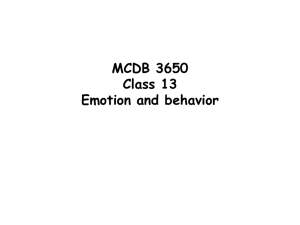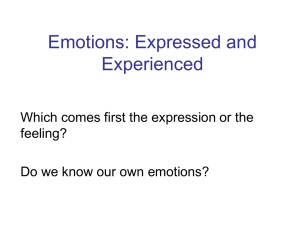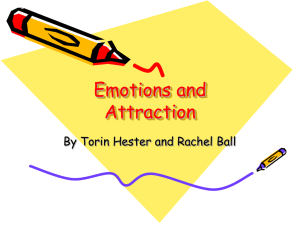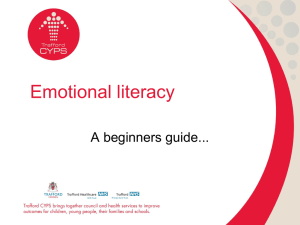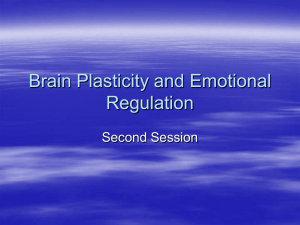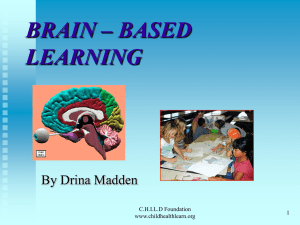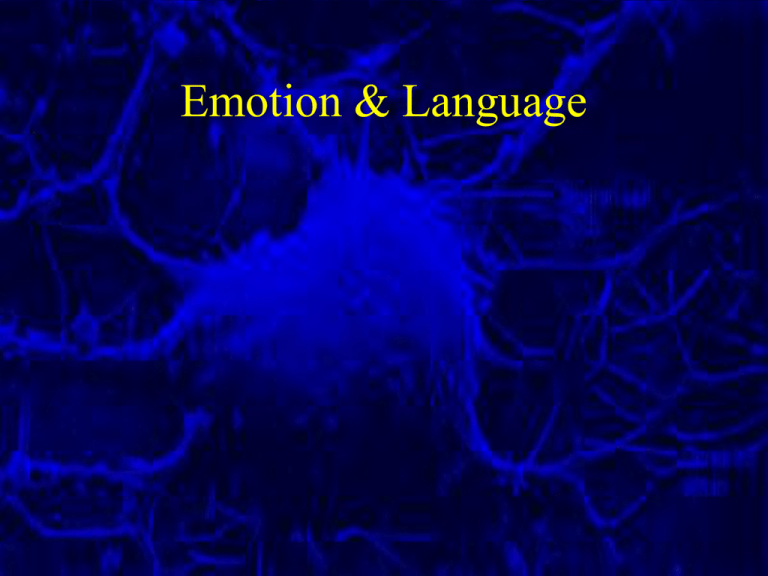
Emotion & Language
Emotion Classifications
• Primary emotions
– Innate, biologically based.
– Arise from sensory experience.
– Same for all humans regardless of culture,
and many animals as well.
– Joy, sadness, fear, disgust, surprise, anger.
• Secondary emotions
– Learned & social, dependent on environment.
– Pride, shame, embarrassment, anxiety.
Universal (Primary) Emotions
• Darwin (1870s) proposed that humans have
developed a finite set of basic emotional
states, common to all humans.
• Ekman and Friesen (1971) studied human
cultures around the world and found that
facial responses to anger, fear, disgust,
happiness, sadness and surprise are universal.
• Many animals show similar emotions.
• Sensory inputs go directly to the limbic areas.
Isolated New Guinea Tribe
“Your friend has come
and you are happy.”
“You are angry and
about to fight.”
“Your child has died.”
“You see a dead pig that has been
lying there for a long time.”
Ekman and Friesen (1971)
Secondary Emotions
• Secondary emotions (pride, shame,
embarrassment, anxiety, etc.) all require
higher cortical processing, and are highly
dependent on learning and social environment.
• Unlike the primary emotions, sensory inputs
must first go to the cortex (frontal lobe), and
then to the limbic areas.
Secondary Emotions
• The frontal cortex is largely responsible.
• Cases of Phineas Gage and Elliot – both lost
control of appropriate emotion from frontal
cortex damage.
• The frontal lobe has also been implicated in
antisocial behavior disorders, and in
schizophrenia, which often features these
symptoms.
• Cannon-Bard (1927): emotional experience can
occur independently of physiological changes.
• James-Lange (1884): we perceive emotion in
response to physiological changes.
The Papez Circuit
• James Papez (1930s) proposed an emotional
system in the limbic cortex (identified by
Broca in 1878) that ties the neocortex to the
hypothalamus, though he had little evidence.
– Rabies affects the hippocampus, and causes
hyperemotional responses.
– Clinical evidence linked anterior thalamus damage
to to spontaneous laughing & crying.
The Papez Circuit
• Hypothalamus
– Governs the expression of emotion thru ANS.
• Cingulate cortex
– Responsible for emotional experience.
• Neocortex
– Colors emotions
• The bidirectional interconnection of emotional
experience and expression areas means the Papez
circuit is compatible with both the James-Lange
and Cannon-Bard theories.
The Papez Circuit
The Primary Emotions
• Damasio (1994) suggested that Ekman’s
universal emotions are innate and controlled
by the amygdala and cingulate cortex.
• Because senses pass thru the thalamus and
proceed to the cortex, and back to the limbic
areas, it was thought that emotional
perception preceded response.
• LeDoux suggested a thalamus-limbic
shortcut that better matches behavior.
Fear
• Fear is good emotion to study since it is innate and
easily conditioned to tones with electric shocks,
loud noises, etc.
• Lesion studies show decerebrate animals still
show conditioned fear responses, so the cortex
cannot be entirely necessary.
• LeDoux showed the amygdala is a crucial part of
the fear circuit. The amygdala is also heavily
involved in sex, anger and aggression. The
hypothalamus is also implicated.
Learned Fear
• Kapp (1984) trained rabbits to distinguish
two tones, one benign and one with a shock.
• Prior to training, central nucleus of the
amygdala did not respond.
• After training, it responded only to the
stimulus associated with the the shock.
• LeDoux (1994) showed that visceral
responses to the tone disappeared after
amygdala lesions.
Learned Fear
• fMRI studies of humans show similar responses.
• Memories associated with fearful conditions are
quickly formed and long lasting. Remember the
amygdala is adjacent to the hippocampus.
• Amygdala is activated during stimuli associated
with punishments, along with cingulate cortex
and insular cortex.
• AP5 (NMDA antagonist) injections into
amygdala inhibit learning of fear responses.
Amygdala
• Surgical studies of the amygdala
– Bilateral amygdalectomy produces a profound
reduction in fear. Stimulation of the lateral amygdala
causes fear and violent aggression in cats.
– S.M. had bilateral destruction of amygdala from
Urbach-Wiethe disease: she lost all recognition of
fear expressions, and most expressions of anger.
– 1966 Charles Whitman kills 30+ in TX. A walnutsized glioblastoma multiforme was found
compressing his amygdala.
Learned Fear
Anger and Aggression
• 2 types of aggression
– Predatory aggression
• Unemotional, for killing, low SNS activation
• Usually quiet
• Stimulation of the lateral hypothalamus.
– Affective/Offensive aggression
• Emotional, for show, high SNS activation
• Lots of vocalizations
• Stimulation of the medial hypothalamus.
Anger and Aggression Summary
• The cortex normally inhibits,
but can excite.
• The amygdala and
hypothalamus are both critical.
• Androgens/steroids can
enhance aggression responses.
• Hypothalamus controls SNS.
• There is evidence for
decreased 5-HT1A and 5HT1B
receptor stimulation.
Emotional Asymmetry
• The right hemisphere is the major site of
visual emotion recognition and is thought to
be the major integrator of emotion.
• The right inferior frontal area is involved in
assessment of audio and visual emotional
content.
• Some theories suggest the right hemisphere is
more responsible for negative emotions, and
the left is more responsible for positive
emotions.
Emotional Asymmetry
Emotional Asymmetry
Posed smile
of pride.
RR’
L’L
Emotional Asymmetry
– Hallervorden (1902) cut copies of facial
pictures in half and joined the same-side halves.
– Most people think the pictures of the left face
are more emotionally expressive during
spontaneous expressions, which would mean
the right hemisphere is more responsible for
emotions.
– The right half of the face is usually more
expressive for posed expressions because
language is on the left.
Emotional Asymmetry
– Type of emotional display matters.
– Posed smiles are controlled by the contralateral
motor cortices. The right side of the mouth
moves first, and generally more than the left.
Left stroke patients cannot smile (or smile
mostly on the left) for a camera.
– Spontaneous smiles of joy seem to originate in
the limbic structures, and the smile is more
balanced. Left stroke patients have less problem
smiling spontaneously.
Language
Language
• Includes oral, written (books, drawings,
etc.), and visual (ASL, flags) language.
• Arguably one of the most important classes
of human social behavior. No non-verbal
human cultures have ever been found.
• The most efficient form of communication
between members of the species.
• Enables learning to be cumulative since we
can pass on our knowledge.
Language Terminology
•
•
•
•
•
a/an- = without
dys- = malfunctioning
-phasic = speech
-lexic = reading
-graphic = writing
• Aphasic = without speech
• Dyslexic = poor reading
Language
• Studies of the bases of language
– Historically limited to observing patients with
aphasias or injuries for obvious reasons.
• Consequences of strokes, trauma, operations, etc.
– Pharmacological tests
• Wada test
– Electrical cortical stimulation tests
– Modern functional imaging techniques have
opened a new chapter on language studies and
brain studies in general.
• MRI, PET, SPECT
History of Language Theories
• 1836 Dr. Dax reported that none of his speechimpaired patients had right hemisphere damage (no
one paid any attention!)
• 1861 Dr. Broca described his patient, Tan, and later 7
more aphasic patients, localizing the area of speech
production to the left inferior prefrontal lobe.
• Liepmann discovered apraxias are limited to patients
with left hemisphere damage.
• This lead to a theory of lateralization.
History of Language Theories
• 1861 Dr. Pierre Paul Broca
described his aphasic patient M.
Leborgne, a.k.a. Tan, who was
known by the only word he
could speak. Dr. Broca
discovered during Tan’s
autopsy that the left inferior
prefrontal cortex, just anterior
to the premotor cortex, was
damaged. Now named for him,
Broca suspected this is involved
in language production.
Tan’s Brain
History of Language Theories
• 1874 Karl Wernicke studied 10
clinical cases and concluded
there is a second language area
in the posterior temporal lobe,
just behind the primary
auditory cortex. He suggested
it is involved in language
comprehension. This is now
known as Wernicke’s Area.
Language
Broca’s Area
Arcuate fasciculus
Wernicke’s Area
Language
• From his model, Wernicke predicted:
– Broca’s aphasia
• Lesions in frontal cortex rostral to base of motor cortex.
• Deficits in expressive language, poor repetition and naming.
• [Nonfluent (no syntax/grammar) speech, mostly “content” words,
but good comprehension,]
– Wernicke’s aphasia
• Lesions in posterior superior temporal lobe.
• Poor comprehension, repetition and naming.
• [Deficits in receptive language, nonsensical fluent speech, no
semantics.]
– Conduction aphasia
• Lesions of the arcuate fasciculus.
• Fluent speech, good comprehension and naming.
• Poor repetition.
Language
• 1891 Jules Dejerine
– On the basis of 1 patient, concluded that the
angular gyrus, just posterior to Wernicke’s area,
is responsible for comprehending languagerelated visual input.
– The patient had alexia and agraphia, but no
deficits in speech.
Language
• Many neurologists of Broca’s and
Wernicke’s time refused to believe their
localization theories.
• 1965 Geschwind re-interpreted and
extended their theories to form the
Wernicke-Geschwind model of language,
including 7 major cortical areas.
Language
• We now know the Wernicke-Geschwind
model is not perfect:
– Lesions to just Broca’s or Wernicke’s areas
seldom produce lasting speech deficits.
– Severing the arcuate fasciculus produces no
permanent aphasia.
– Electrical stimulation studies show diffuse and
non-specific areas.
– Wernicke’s area lesions affect speaking as well.
Language
• Studies of dyslexics and Steve Petersen’s
PET studies in 1989 lead to the Dual-Route
theory of language processing:
– Lexical Route
• Well-practiced or known verbal responses.
• Whole-word recognition.
– Nonlexical Route
• Novel or complex verbal responses.
• Must apply a standard set of rules.
Lexical Processing
• Count how many “F”s are in the sentence
on the next slide as quickly as you can.
Lexical Processing
• FINISHED FILES ARE THE RESULT
OF YEARS OF SCIENTIFIC STUDY
COMBINED WITH THE EXPERIENCE
OF YEARS.
Lexical Processing
• The phaomnenel pweor of the hmuan mnid.
Aoccdrnig to a rscheearch at Cmabrigde Uinervtisy,
it deosn't mttaer in waht oredr the ltteers in a wrod
are, the olny iprmoetnt tihng is taht the frist and
lsat ltteer be at the rghit pclae. The rset can be
a total mses and you can sitll raed it wouthit
porbelm. Tihs is bcuseae the huamn mnid deos not
raed ervey lteter by istlef, but the wrod as a wlohe.
Dual-Route Theory
Received Words
Lexical Route
(Temporal Lobe)
Lexicon
Nonlexical Route
(Frontal Lobe)
Rules
(phonetics)
Speech Production
Language
• Dual-route processing deficits:
– Surface dyslexia
• Lexical route deficit.
• Left lateral temporal lobe lesions.
• Inability to pronounce words based on specific memories.
– Deep dyslexia or phonological dyslexia
• Nonlexical route deficit.
• Left frontal lobe damage.
• Inability to sound out new words.
• The non-dominant cortex is
involved in prosody, the flow
and rhythm of speech which
often carries emotional
content, both in understanding
and production.
• Aphasias of prosody can
render a patient unable to
detect or produce the proper
emotional content in speech.
• Deficits in receptive emotion
are often found in the area
contralateral to Broca’s area.
Emotional
Language

